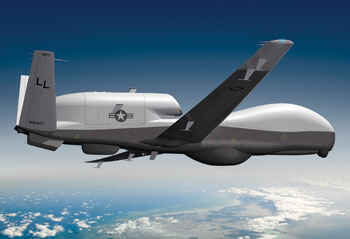INDIAN ARMED FORCES CHIEFS ON
OUR RELENTLESS AND FOCUSED PUBLISHING EFFORTS

SP Guide Publications puts forth a well compiled articulation of issues, pursuits and accomplishments of the Indian Army, over the years

I am confident that SP Guide Publications would continue to inform, inspire and influence.

My compliments to SP Guide Publications for informative and credible reportage on contemporary aerospace issues over the past six decades.
India To Be Offered US Navy’s Future UAS?
By SP's Special Correspondent February 08, 2013: Northrop Grumman will for the first time highlight the MQ-4C Triton long endurance unmanned air system at Aero India 2013. The underdevelopment system is being created under the Broad Area Maritime Surveillance (BAMS) programme that Northrop Grumman won in 2008.
February 08, 2013: Northrop Grumman will for the first time highlight the MQ-4C Triton long endurance unmanned air system at Aero India 2013. The underdevelopment system is being created under the Broad Area Maritime Surveillance (BAMS) programme that Northrop Grumman won in 2008.
The system was officially unveiled in June last year. In a statement, Northrop Grumman has said, “Triton is a maritime version of the combat-proven Global Hawk unmanned aircraft system. Developed for the US Navy, Triton can fly missions for 24 hours at altitudes more than 14 kilometres, allowing the system to cover vast areas of ocean and coastal regions.
The Navy developed its future concept for maritime patrol using Triton in conjunction with the P-8 Poseidon, a manned surveillance platform that has also been purchased by the Indian Navy. Sources say the company plans to take forward discussions on the Triton based on the proposition that the Indian Navy’s choice of the Boeing P-8 makes the Triton a logical choice for the Indian Navy, since it is being developed for operations alongside the US Navy’s fleet of Boeing P-8A Poseidon jets.
According to Northrop Grumman literature on the MQ-4C Triton, it “provides the U.S. Navy with an advanced autonomous air vehicle and state-of-the-art, service-oriented architecture mission control system. Incorporating Navy requirements into a family of air vehicles that are in production and combat proven provides a cost-effective system with the greatest capability at the lowest risk.”
Key features of the Triton are said to include persistent maritime ISR at a mission radius of 2,000 nm; 24 hours/7 days per week with 80 per cent Effective Time on Station (ETOS), land-based air vehicle and sensor command and control, afloat Level II payload sensor data via line-of-sight, dual redundant flight controls and surfaces, 51,000-hour airframe life, due regard radar for safe separation, anti/de-ice, bird strike, and lightning protection, communications bandwidth management, commercial off-the-shelf open architecture, mission control system, net-ready interoperability solution.
The other “marinised” unmanned air systems at Aero India vying for the Indian Navy’s attention are the Elbit Systems Hermes 900 MP and the Boeing Insitu Scan Eagle.





